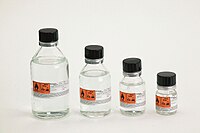
Photo from wikipedia
Although the electrocatalytic nitrate reduction reaction (NO3 - RR) is an attractive NH3 synthesis route, it suffers from low yield due to the lack of efficient catalysts. Here, this work… Click to show full abstract
Although the electrocatalytic nitrate reduction reaction (NO3 - RR) is an attractive NH3 synthesis route, it suffers from low yield due to the lack of efficient catalysts. Here, this work reports a novel grain boundary (GB)-rich Sn-Cu catalyst, derived from in situ electroreduction of Sn-doped CuO nanoflower, for effectively electrochemical converting NO3 - to NH3 . The optimized Sn1% -Cu electrode achieves a high NH3 yield rate of 1.98 mmol h-1 cm-2 with an industrial-level current density of -425 mA cm-2 at -0.55 V versus a reversible hydrogen electrode (RHE) and a maximum Faradaic efficiency of 98.2% at -0.51 V versus RHE, outperforming the pure Cu electrode. In situ Raman and attenuated total reflection Fourier transform infrared spectroscopies reveal the reaction pathway of NO3 - RR to NH3 by monitoring the adsorption property of reaction intermediates. Density functional theory calculations clarify that the high-density GB active sites and the competitive hydrogen evolution reaction (HER) suppression induced by Sn doping synergistically promote highly active and selective NH3 synthesis from NO3 - RR. This work paves an avenue for efficient NH3 synthesis over Cu catalyst by in situ reconstruction of GB sites with heteroatom doping.
Journal Title: Small
Year Published: 2023
Link to full text (if available)
Share on Social Media: Sign Up to like & get
recommendations!